White Buddhist Practitioners Gather in Seattle
To See, Challenge and Break Tangles of Racism
Written by: Anna-Brown Griswold, Ruby Phillips, and Denis Martynowych
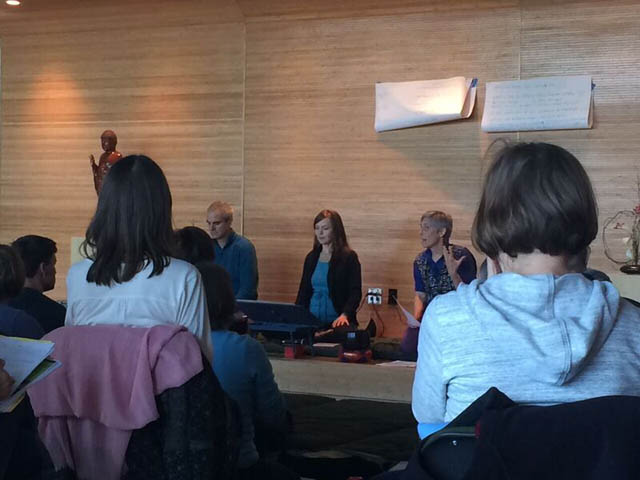
The three teachers guided participants in better understanding their whiteness, and unconscious attitudes about race.
Photos by: Diane Hetrick , Denis Martynowych
In June more than 60 people, most of whom self-identified as white, gathered at the Seattle Insight Meditation Center for a “Day of Mindfulness for White Allies.”
They brought their open-hearted willingness to learn and grow, and a commitment to support one another to heal from the inner and outer effects of racism. They came from their own eagerness to learn and participate in their Buddhist sanghas’ efforts toward authentic inclusion and safety.
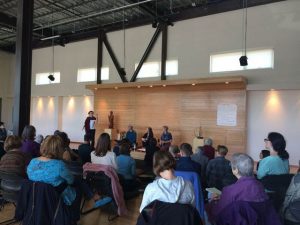
Sooz Appel began the day by greeting everyone to the Seattle Insight Meditation Center.
Our honest and vulnerable work together, to understand racism, exposes some of the deepest obstacles to our personal and collective liberation. Many of the core teachings and practices of Buddhist tradition offer powerful tools to assist us in this essential effort to make our lives and our dharma communities more diverse and inclusive.
Racism is one particularly potent form of delusion, and the tools the dharma offers for untangling delusion are powerful.
At the June meeting, the primary dharma practices we utilized to begin tackling our delusion, and its subsequent harm, were sitting meditation, Insight Dialogue, and investigation.
Insight Dialogue is a relational meditation that brings the stillness and acute mindfulness of silent sitting into dialogue. It helps cultivate each co-meditator’s capacity to investigate their experience deeply, and then name it.
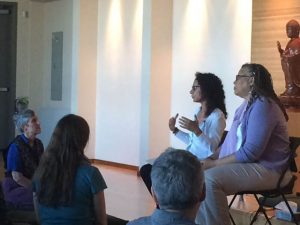
Vera Garibaldi and Tuere Sala offering their experience of practicing the dharma in a predominantly white Buddhist community.
We began the day with a guided meditation to ground in our bodies, connect with our deepest intentions for the day, and recognize the basic goodness of our own minds.
This served as a foundation for the day because by taking refuge in our basic goodness, we can more skillfully turn toward the difficult and emotionally-loaded terrain of racism, rather than turn away or shut down in shame or fear.
Research has indicated that the shame and defensiveness that arise for many white people, upon hearing about systemic and personal racism, block new learning and changing behavior.
As a response, we supported people at the day of mindfulness to actually experience the sensations of shame and fear in the body. We led them in feeling and moving through discomfort to act on their deepest intentions, rather than being mired in shame and defensiveness.
This practice can transform people’s experience of shame into compassionate wisdom, and the seeds for wholesome action, becoming a dharma doorway for liberation.
Four levels of racism
The team introduced the framework of the four levels of racism: internalized, interpersonal, institutionalized and systemic. This familiarized everyone with the basic concepts, and how they operate within ourselves and in the culture. This framework helps broaden understanding of how racism might be manifesting at any particular moment, often on multiple levels at once.
We introduced the first Insight Dialogue guideline practice of “pause,” as the first step of supporting ourselves to notice what is happening. This pause, or noticing, is an essential skill in interrupting the endless cycle of unaware and automatic reactions.
Pause became the foundation for beginning to recognize how some of these dimensions of racism live in our own hearts and minds. We introduced pausing, noticing, and then naming the body sensations and thought streams, as the primary doorway to a clearer awareness of what is actually happening in the moment.
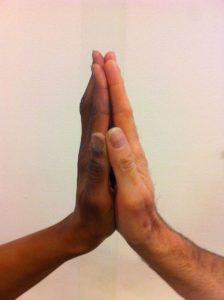
Two hands, symbolizing human unity despite differences.
This foundational Buddhist practice is extraordinarily helpful in noticing and unraveling the confusion and unskillfulness we all struggle with around race.
Building on this foundation, we turned our attention to exploring of implicit bias. Implicit bias results from subtle cognitive processes that often operate at a level below conscious awareness and without our intentional control. Everyone was encouraged to take one of the many implicit bias tests offered by Harvard University’s Project Implicit.
Our mind streams are filled with automatic thoughts. When someone says “Jack and Jill went up the….,” we automatically fill in “hill.” Automatic thoughts that form bias are unavoidable and can be useful as well as problematic.
When these automatic thoughts arise out of internalized racial misinformation or confusion, they form biases that distort reality. For example, racial bias results in unfair treatment and all-too-frequent deaths of people of color, especially black men, at the hands of police.
In our lives and in our Buddhist communities, unconscious racial biases condition the interactions of white people with people of color, enough for the latter to feel uncomfortable and unwelcome.
By definition we can’t stop automatic thoughts nor can we use our will to force bias out of our minds. However, we can begin to open a doorway to choose how we respond to these automatic racialized thoughts. For instance, we can use the practice of “pause” to notice these thoughts as they arise, rather than habitually acting on them.
With awareness, we can choose words and actions that open up connection and respect, instead of reinforcing separation.
We can also introduce and reinforce automatic thoughts that are wholesome. Repeated phrases used in the Buddhist practices of loving kindness can shift deeply rooted negative patterns of judgment towards self and others. Research has shown that with the right phrases this practice can change racial bias as measured by the Harvard test mentioned above.
During the daylong we repeated phrases like “May we all be free of the pain and suffering caused by racism.” We encouraged participants to craft personally meaningful similar phrases, and to regularly offer them with love in their own daily practice.
During lunch some people met with their sangha members to discuss ways to welcome people of color to those sanghas.
Encounters with White Fragility
In the afternoon, we explored the phenomenon of “white fragility.” A term coined by Seattle-based race equity educator Robin DiAngelo, it refers to defensive patterns that can arise in white people who encounter the karmic results of centuries of racism, including anger and grief expressed by people of color.
If white people want to be part of racial healing, it’s time for us to listen. Many well-meaning white people want to listen, but get triggered when our conditioned sense of entitlement is disturbed.
Instead of hearing others’ pain, we can interpret expressions of pain from people of color as attacks. If we are not mindful we can easily react with blaming, shutting down, claiming exemption, or responding with a platitude. These reactions usually just continue the cycle of misunderstanding and separation.
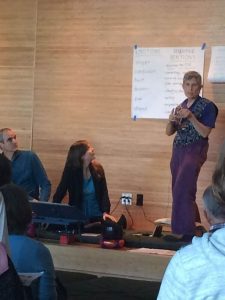
Ruby Phillips explaining white fragility.
Fortunately, our Buddhist practices of mindfulness and investigation are wonderful tools for us to develop stamina, to replace fragility. If we are able to focus attention inwardly, identify arising emotions like anger, shame, fear and confusion, and consciously feel body sensations, we can hold our uncomfortable experience with full acceptance. Then we can watch as discomfort transforms into wisdom and wholesome intention.
Support from a partner, through use of Insight Dialogue, helps people feel safe enough to stay with discomfort, and move to an insightful perspective.
A highlight was hearing from Tuere Sala, co-guiding teacher of Seattle Insight Meditation Society; and Vera Garibaldi, from Mindfulness Community of Puget Sound; about their experiences as people of color in predominantly white sanghas.
Their open-hearted, courageous expressions of racialized suffering in sangha moved many of us very deeply. Their talks inspired some sanghas to launch initiatives for authentic racial welcoming.
For our final learning of the day, we explored the rich terrain of microaggressions. Columbia University Professor Derald Sue defines microaggressions as “brief and commonplace daily verbal, behavioral, or environmental indignities, whether intentional or unintentional, that communicate hostile, derogatory, or negative racial slights and insults toward people of color.”
Although white people often are unconscious their expression is hurtful, the pain experienced by people of color from microaggressions is very real. We explored three ways that microaggressions occur: within oneself, within white-only groups, and within racially mixed groups.
We also explored how each of these requires a different strategy to transform power dynamics. We also explored what’s needed for people of color to feel safe.
We paired up to use Insight Dialogue practice to investigate the body sensations, thoughts and emotions that underlie these macroaggressions. Our goal was to become more than just silent bystanders when witnessing micro-aggressions, as well as to reduce our own tendencies to microaggress.
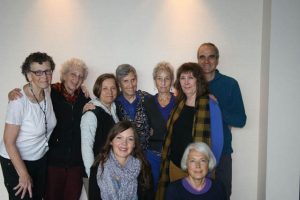
The volunteer team and teachers supported a significant event.
With this as a foundation, we continued in Insight Dialogue pairs to touch into the qualities of heart and mind we would need for courageous and skillful speech.
As we moved back into the large group for brainstorming and role-playing exercises, the group was riveted, bursting with questions about how to be truly respectful of the experiences of people of color.
The day concluded with a dedication of merit, offering the benefit of our collective work to the benefit of all beings without exception. As more and more white people recognize the centrality of ending racism to their own awakening, and honestly express it in their words and actions, our beloved dharma communities can become authentically diverse, safe and liberating for everyone.
If you are interested in participating with a group that meets monthly to continue to explore this territory, please contact: Denis Martynowych denismarty@gmail.com (206) 201-6596, or Ruby Phillips rubydoobe@gmail.com (206) 323-5503.
In addition to SIMS the day of mindfulness was co-sponsored by multiple Seattle sanghas: Mindfulness Community of Puget Sound, People of Color and Allies Sangha, Lotus Sisters, Dai Bai Zan Cho Bo Zen Ji Seattle Zen Temple, and Seattle Eco-Sattva Sangha.
Ruby Phillips has a longtime commitment to liberation through Buddhist practice and human/environmental rights activism. She has been practicing Buddhist meditation for 30 years, and enjoys participating regularly with three Seattle sanghas.
Denis Martynowych began meditating 16 years ago primarily in the Insight (Theravada) tradition. He completed the Community Dharma Leaders training program. Using the teachings of mindfulness and compassion to helping overcome the disease of racism inside himself and others, is a natural outgrowth of his long interest in the relationship between inner and outer liberation.
